Is there anything more delicious than a fresh raspberry straight off the bush? Raspberries are one of summer’s most welcome treats, and growing your own can be easy and rewarding. With just a little bit of space, you can plant a raspberry bush that will bear fruit for years to come.
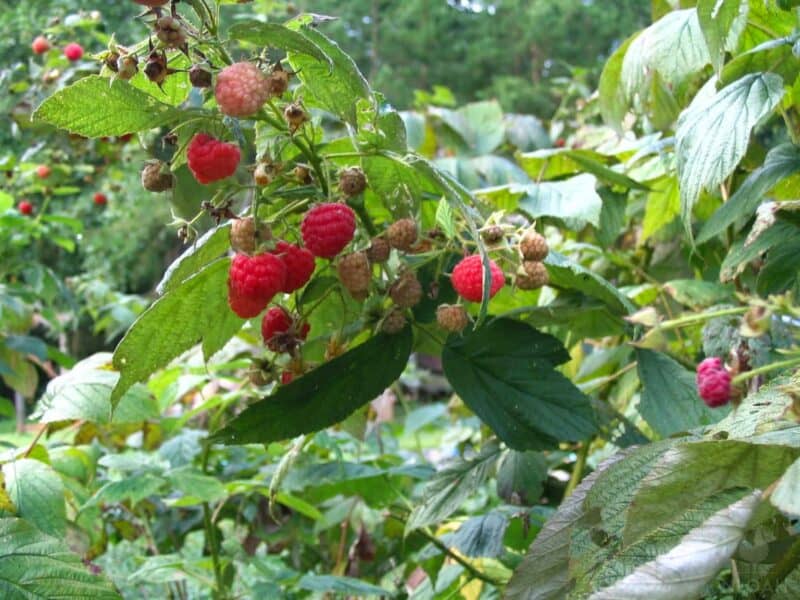
Ready to get started? Read on for everything you need to know about growing raspberries!
What is the Best Way to Plant a Raspberry Bush?
When it comes to planting raspberry bushes, there is no one-size-fits-all solution. The best way to plant depends on the climate, the type of soil, and the variety of bush.
Raised Beds vs. In the Ground
Raspberries are a delicious summer fruit, and they can be easily grown in either raised beds or in the ground.
One of the main benefits of using raised beds is that they improve drainage and prevent the roots from being waterlogged. They also protect the plants from pests and diseases that might be present in the soil.
Raised beds can also be made from a variety of materials, including wood, stone, or even plastic. However, one downside of raised beds is that they can be more expensive to construct than simply planting the berries in the ground.
In addition, raised beds can dry out more quickly than ground-level plantings, so it is important to water them regularly.
Ground-level plantings have the advantage of being less expensive and easier to establish. However, they are more likely to be waterlogged during heavy rains, and the roots may be more vulnerable to pests and diseases.
When deciding whether to plant raspberries in raised beds or in the ground, it is important to consider your local climate and soil conditions.
Where is the Best Place to Plant?
Raspberries prefer full sun and well-drained soil. They also need room to spread out, so be sure to give them plenty of space when planting. Once they’re in the ground, raspberries are relatively low-maintenance.
Where You Shouldn’t Plant Raspberries
Raspberries thrive in sunny locations with well-drained soil, so avoid planting them in shady areas or in poorly drained soils. In addition, raspberries should be planted in a location where they will not be disturbed by other activities, such as mowing the lawn or playing sports.
How Much Space Do the Roots Need?
When it comes to raspberry roots, more isn’t necessarily better. In fact, giving them too much space can actually be detrimental to their health.
Raspberry roots are very shallow, only extending about six inches into the ground. This shallow root system allows the plant to absorb water and nutrients quickly, but it also makes the plant susceptible to drought and heat stress.
As a result, raspberry roots need to be kept moist at all times. Mulching with organic material such as wood chips or straw can help to create a microclimate around the roots that will help to keep them cool and moist. Mulch is essential, in my opinion, especially around delicate new canes in the first year of growth.
Do Raspberries Grow Better in Pots or Ground?
Either works! Growing them in pots or other containers that can be moved around will make it easy to give them the amount of sun they need.
Finally, it is important to choose a container that is large enough to accommodate the roots of your raspberry plants. A pot that is too small will limit the growth of your plants and result in fewer berries. In general, a pot that is at least 12 inches wide and 18 inches deep will work well for most raspberry varieties.
Best Time to Plant Raspberries
For best results, raspberries should be planted in the spring. This gives the plants a chance to establish strong roots before the hot summer sun arrives. However, if you live in an area with cool summers, you can plant raspberries in early summer. Just be sure to give them plenty of water until they are well established.
Ultimately, the best time to plant will depend on what kind of raspberries you’re growing. Are they ever-bearing? Summer-fruiting raspberries or summer-bearing raspberries? Fall-bearing raspberries? One-year-old canes? Second-year canes?
All of these factors matter when it comes to timing your planting. Buy your plants from a reputable nursery and ask about the ideal planting time when you do.
How Deep Do Raspberry Bushes Need to Be Planted?
The hole for the bush should be wide enough to accommodate the roots, and deep enough so that the crown of the plant is just above ground level. In general, raspberry bushes need to be planted about two feet apart.
How Long Do They Take from Flower to Fruit?
It typically takes between 60 and 70 days for the fruit to mature. Raspberries first flower in early spring, and the blooms typically last for two to three weeks. After pollination occurs, the flowers begin to form small green berries.
These berries gradually turn red as they mature, and they are typically ready to harvest in late summer or early fall. However, the exact timing depends on the variety of Raspberry plant, as well as the growing conditions. For example, warmer temperatures can cause the fruit to ripen earlier than usual.
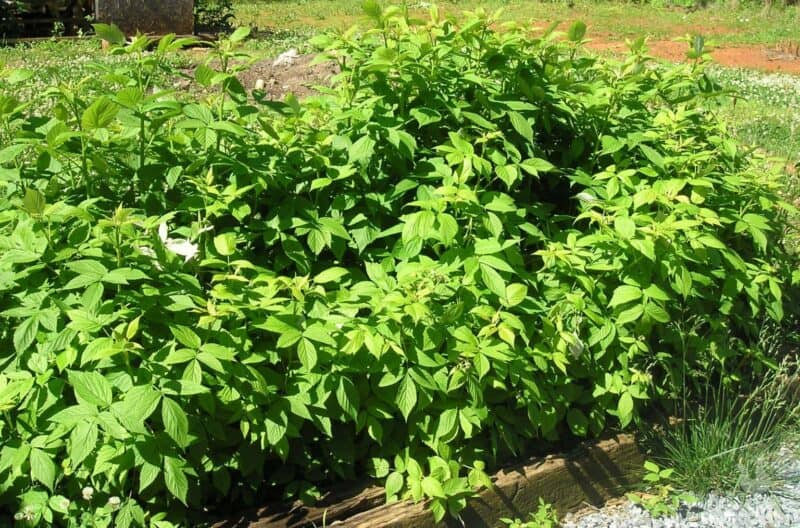
Deciding How Many Bushes to Plant
Any gardener worth their salt knows that one of the most important decisions when planting a raspberry bush is deciding how many bushes to plant. After all, if you plant too few, you won’t get enough raspberries. But plant too many, and you’ll be stuck with more than you can handle.
So how can you make sure you get it just right?
The answer, unfortunately, is that there’s no easy answer. It depends on factors like the size of your yard, the amount of sun it gets, and the amount of time you’re willing to spend caring for your bushes.
However, there are a few general guidelines you can follow. If you’re just starting out, it’s generally advisable to start with just a few bushes. That way, you can get a feel for how much work they require before committing to a larger number.
You should also take into account the amount of space you have available.
Raspberries need room to spread out, so if you’re tight on space, you may want to stick to just a few bushes.
How Many Raspberries Will One Plant Yield?
One plant can yield anywhere from 24 to 36 raspberries. This depends on the variety of raspberry, how well the plant is taken care of, and if the plant is grown in ideal conditions. When factoring in different variables, it is difficult to give an exact number. Though, on average, one plant will produce about 30 raspberries.
Do You Need Two Raspberry Bushes to Produce Fruit?
The answer is no – one raspberry bush will produce plenty of fruit! However, there are a few things to keep in mind in order to ensure a bountiful harvest.
First, make sure to choose a variety that is self-pollinating – this will ensure that your bush produces fruit even if there isn’t another one nearby. Second, be sure to give your bush plenty of sun and water – both of these are essential for healthy growth and fruit production.
Making the Raised Bed
Last week, we drove to a local man’s house and bought some raspberry bushes. I couldn’t pass up $4 per bush! Plus, he totally hooked us up.
We were only going to get 6, but he threw in 6 extra, which was wonderful. He also invited us to come back and get some flowers and strawberries. I told him I’d bring him a loaf of freshly baked bread in return.
A couple of years ago, we bought peaches from this same man, and he let us glean from his raspberry bushes.
The kids had so much fun picking, and definitely ate way more than they put in their baskets. His raspberries were melt-in-your-mouth good. I’m excited to be growing some of the same variety myself!
And now that we don’t have crazy goats free ranging the property, maybe they’ll have a chance to actually produce!
I’ve been wanting to line the parking area of our driveway with raised beds for a while now, since that spot gets full sun almost all day long, so this is where we decided to plant the raspberries. We had some extra railroad ties laying around, which were perfect for this project.
Line Up the Railroad Ties
The first thing to do was to line up the railroad ties where I wanted them. I spaced them a little over 3 ft. apart. I might have to move them slightly though:
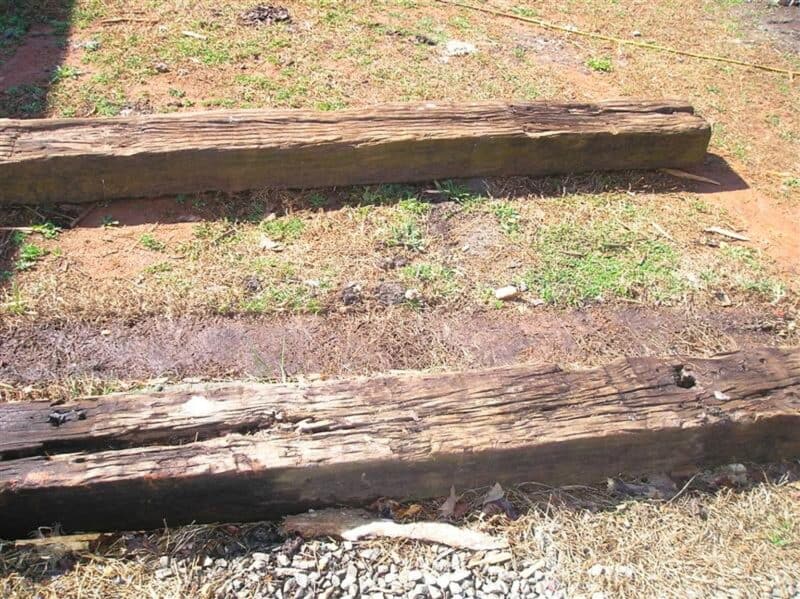
The railroad ties are a little over 8′ long, and we’ll be cutting a few in half to make end pieces for the beds. I should have measured how long half of one of these railroad ties would be before spacing my beds. It might be close though.
Put Down a Weed Barrier and Some Compost
I covered the ground with cardboard as a weed barrier. You could also use several layers of newspaper (not the colored pages):
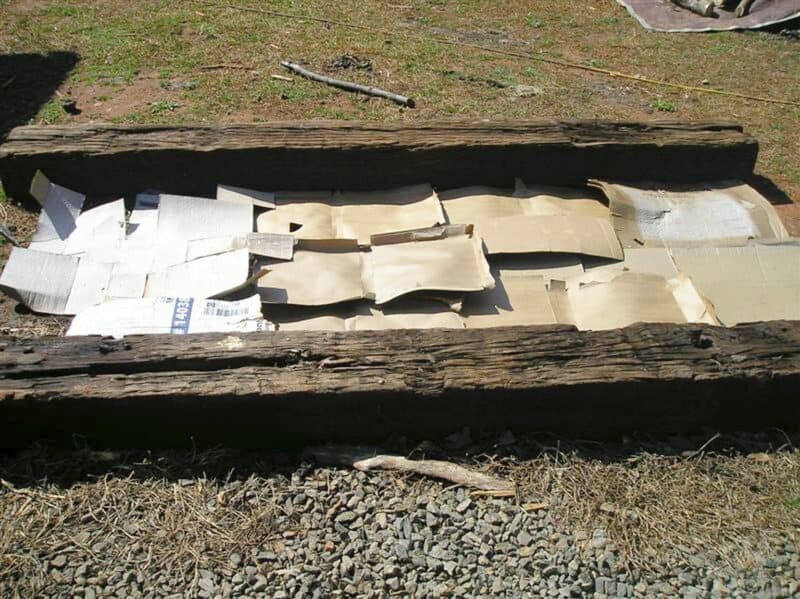
Next, I filled it with compost. We ordered a couple of dump truck loads this year for our garden. About a billion shovelfuls of this stuff later, and my bed was ready for planting:
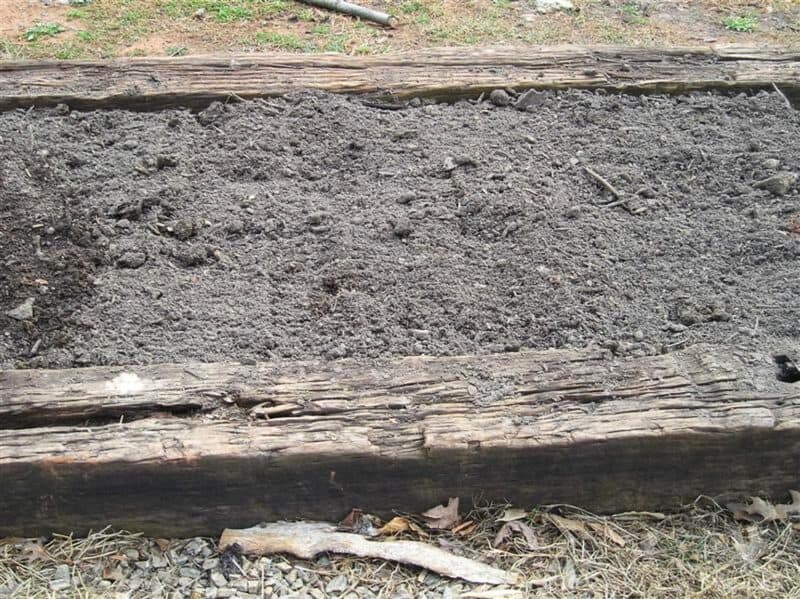
Here is what the raspberry bushes looked like:
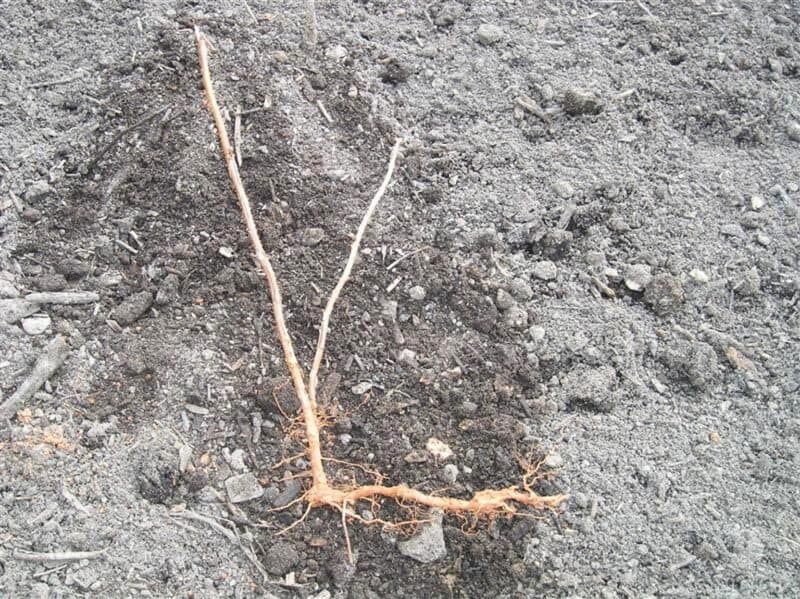
Not exactly what I tend to picture when I think of buying a bush. These are “bare root” plants. The man we bought them from had just dug them up. Don’t worry, they’ll be beautiful green plants in no time!
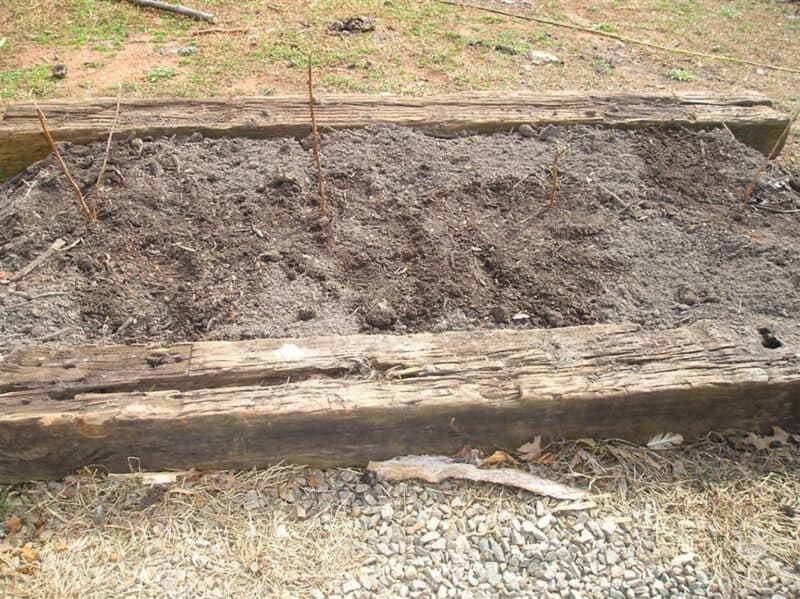
Planting the Raspberries
I spaced them 24 inches apart, and buried them deep enough to cover the roots and wide enough that the roots could spread out freely. Doesn’t look like much now, but I envision a beautiful, edible hedge one day.
…and Repeat!
After finishing up this bed, I created two more just like it. And was incredibly grateful when my husband came home in time to help me fill the last beds with dirt. Boy, was I sore from all that shoveling!
Which reminds me of something I thought was really cute… so I’ll share.
At one point while I was out there working in the heat of the day, I became aware of a pair of little eyes studying my efforts. I wondered what Titus was thinking as he watched his mommy toiling away.
After a few good minutes of pondering from a short distance, he walked up to me and said, “Here Mommy, let me have that,” and he reached out to take the shovel from my hand. I was hesitant to let him have it though…
I felt bad allowing my five year old to work that hard on a hot day. But I saw an opportunity to allow him to feel the satisfaction of helping, and really stepping up in a manly sorta way, and so I smiled and handed it over.
I was surprised by how much dirt that boy could move! What a precious little guy. I stopped him after a few minutes, and suggested we go inside for a glass of sweet tea to cool us off from such hard work. We rarely give the kids sweet tea, so that was my way of rewarding and thanking him.
As we went inside he said to me, “I just felt bad that you were out here working so hard all by yourself!” And my heart melted with pride. He is turning into such a thoughtful, compassionate guy. I hope to always encourage that.
So, anyways… thought I’d share that cute story with you to wrap up this tale of building raspberry beds!
Caring for Raspberry Bushes
Here are a few tips to help you care for your raspberry bushes once they’re in the ground.
Watering
In order to produce abundant fruit, raspberry bushes need to be evenly watered throughout the growing season. However, too much water can be just as harmful as too little. Overwatering can lead to root rot, which can kill the plant. Consider using drip irrigation to give your plants the moisture they need and make sure your container has good drainage.
In addition, raspberry bushes are susceptible to powdery mildew and other fungal diseases if the leaves stay wet for too long. As a result, it is important to water raspberry bushes in a way that provides adequate moisture without leading to excess wetness. One way to do this is to water early in the day so that the leaves have time to dry off before nightfall.
Weeding
Make sure to weed regularly, before the perennial weeds have a chance to take over. Second, use the right tools for the job. A hoe or trowel can be helpful for larger weeds, while a small hand-held tool is ideal for smaller ones. Finally, pay attention to the roots when you weed. This will help to prevent the weeds from coming back.
What is the Best Fertilizer Mix for Raspberries?
When it comes to fertilizing raspberries, there is no one-size-fits-all approach. The best fertilizer mix for raspberries will vary depending on the type of raspberry plant, the soil conditions, and the time of year.
However, there are some general guidelines that can help you choose the best fertilizer mix for your raspberry plants. First, consider the needs of your particular raspberry plants. Raspberries are heavy feeders, so you will need a fertilizer that is high in nitrogen. Manure is a great choice.
However, too much nitrogen can lead to leaf growth at the expense of fruit production, so you’ll also need to Balance the nitrogen with other nutrients like phosphorus and potassium.
You should also consider the pH level of your soil when choosing a fertilizer mix. Raspberries prefer slightly acidic soil, so a fertilizer with a low pH level is ideal.
Finally, make sure to choose a fertilizer that is specifically designed for fruit plants. This will ensure that your raspberries get the right mix of nutrients to produce bountiful crops.
How Do You Acidify Soil for Raspberries?
Raspberries are a type of fruit that thrive in acidic soil. The ideal pH level for raspberry plants is between 6 and 7. If your soil is too alkaline, you can acidify it using a variety of methods.
One common way to acidify soil is to add pine needles or shredded leaves. These materials will help to lower the pH of the soil over time. You can also use sulfur-based products to acidify the soil more quickly.
However, be sure to follow the directions carefully, as too much sulfur can damage the plants. Another option is to plant raspberries in raised beds filled with acidic potting mix or compost. This will provide the plants with the conditions they need to thrive without affecting the rest of your garden.
Pest and Disease Control
Raspberries are a delicious and nutritious addition to any garden, but they can be vulnerable to pests and diseases. To keep your raspberry patch healthy, it is important to regularly check for signs of problems and take action to control any that are present such as the very common raspberry worm.
Aphids, mites, and Japanese beetles are all common pests that can damage raspberry plants.
Powdery mildew and botrytis infection are two of the most common diseases that affect raspberries. Verticillium is a common virus that affects raspberries, too.
Fortunately, there are many effective ways to control pests and diseases in raspberries. Insecticidal soap can be used to control aphids, mites, and Japanese beetles. fungicides can help to prevent powdery mildew and botrytis infections.
How to Keep Scavengers Away From Your Raspberry Bushes
One of the most frustrating things for a raspberry enthusiast is finding that their plants have been raided by animals. Whether it’s birds, deer, or even small mammals like squirrels, these pests can quickly decimate a crop. But there are a few things you can do to keep animals away from your raspberry plants.
One effective method is to erect a physical barrier around the perimeter of the garden, such as a fence or netting. This will block animals from being able to access the plants directly.
Another good strategy is to use traps or poisonous baits, which can help to catch or deter pests before they have a chance to do any damage.
How to Harvest Your Raspberries
Wait until the berries are fully ripe before picking them. Raspberries will continue to ripen after they are picked, so it is best to wait until they are deep red and soft to the touch. Second, be gentle when picking the berries.
Gently twist each berry off of the stem, taking care not to damage the fruit. Eat or refrigerate the berries as soon as possible after picking them. Raspberries are delicate and will only last a few days at room temperature.
What Grows Well Next to Raspberries?
Herbs such as basil, rosemary, and thyme can all be planted alongside raspberries and will help to deter pests. Taller plants such as sunflowers or tomatoes can also be planted next to raspberries, as they will provide shade and protect the berries from the harsh summer sun.
And finally, companion plants such as marigolds or nasturtiums can help to attract pollinators like bees and butterflies, which are essential for the health of your raspberry plants.
When it comes to what NOT to plant with your raspberry floricanes and primocanes, bad companions include:
- Potatoes
- Tomatoes
- Peppers
- Eggplants
Do Raspberry Plants Spread?
The good news is that raspberry plants do spread, and they’re relatively easy to propagate. When raspberries are ripe, the fruit detaches easily from the plant. This means that if you have a neighboring raspberry bush, the fruits can fall into your yard and take root.
Raspberry plants can also spread through runners, or long stems that grow along the ground. While this can be helpful if you’re trying to expand your raspberry patch, it can also be a bit of a nuisance if you’re trying to keep the plants contained.
Fortunately, there are a few simple methods for controlling the spread of raspberry plants. For example, you can cut back the runners regularly, or you can choose a variety that produces fewer runners.
Growing in a raised bed, as I described above, is another viable option!
Keeping Chickens Around Your Raspberry Bushes
Chickens are wonderful creatures that lay delicious eggs and provide delightful company. They are also excellent pests control agents and can help keep your raspberry bushes healthy and free of pests.
Chickens will eat just about any type of bug, including the larvae of moths and beetles, which can destroy a raspberry crop. In addition, their scratching and digging help to aerate the soil, which is essential for good plant growth.
The only problem with keeping chickens with your raspberry bushes is that they may eat the fruits. Typically, the thorns will deter them, but that’s not always the case.
If you’re not willing to take the risk, I recommend keeping your chickens around the plants only before they’ve produced fruit and at the end of the season, after you’ve harvested. You can also put poultry netting around the plants so the chickens can still work around the plants, but not get to the fruit.
So if you’re looking for a way to naturally control pests and improve the health of your raspberry bushes, consider keeping a few chickens around.
What to Do With Your Raspberry Harvest
You’ve been waiting all summer and finally, it’s time to harvest your raspberries! But what now? There are so many delicious things you can do with your raspberries, the possibilities are nearly endless.
Here are a few tips on how to best preserve raspberries:
- Rinse raspberries gently with cool water and remove any leaves or stems.
- Spread the raspberries in a single layer on a paper towel-lined tray and pat dry.
- Place the raspberries in a clean, dry container with vents, such as a colander or plastic storage container with holes punched in the lid. If using a storage container, line it with paper towels to absorb moisture.
- Store the raspberries in the refrigerator for up to three days. Eat them as soon as possible for the best flavor.
- You can also can the raspberries by themselves or with other ingredients to make jelly or jam. Raspberries can be frozen, too.
Now, raspberries are a delicious and versatile fruit that can be used in a variety of recipes…
For a quick and easy snack, simply mix raspberries with yogurt and honey. Or, for a more refreshing treat, try blending raspberries with lemon juice, mint leaves, and sparkling water.
If you’re looking for something heartier, raspberries can also be used in savory dishes. Try adding them to salads or using them as a topping for grilled chicken or fish.
Here are a few of my favorite raspberry recipes:
Final Thoughts
Most raspberry canes need to be trellised and a good prune job, we won’t need to build a support system for this variety of raspberries. They are an “Everbearing Heritage” variety, and should produce heavily.
And what’s cool is that raspberry bushes spread really fast, so I’ll be able to get even more plants off of these in the coming years.
Oh, and dried raspberry leaves make a wonderful herbal tea. I drank it a lot during my pregnancy, so it’ll be great to have a fresh source directly!
I’m so excited!! Can’t wait to have more perennial edibles on our land!
UPDATE: Here’s a photo of the raspberry bed almost exactly one year after planting. Looking good! I’ll need to thin out the new growth and transplant the shoots elsewhere so it doesn’t overcrowd:
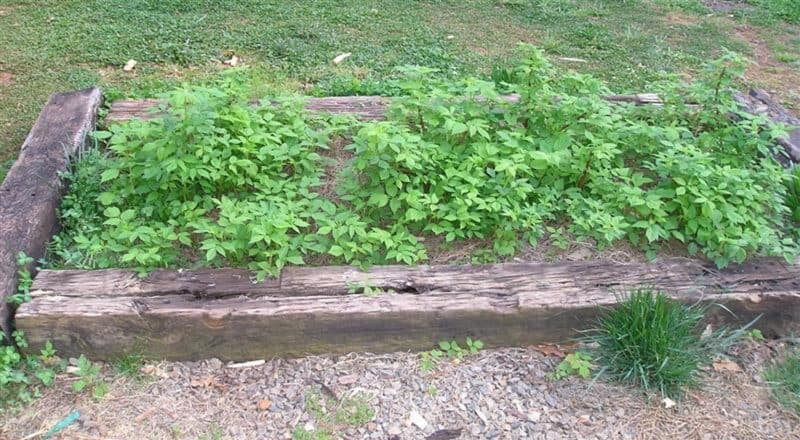
Aug. UPDATE: Here’s a photo of our raspberry bushes about a year and a half after planting. Really producing strong now!…
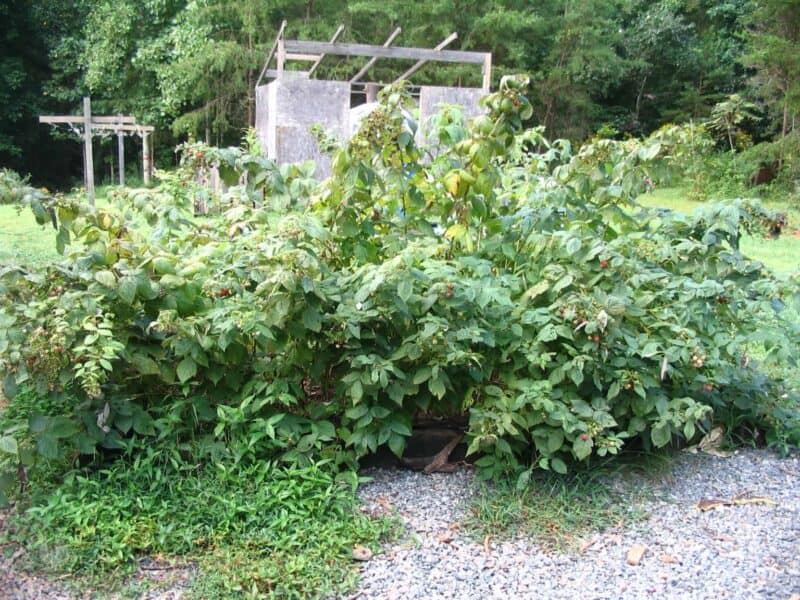
And there you go! That’s all it takes to plant raspberry bushes.

A city girl learning to homestead on an acre of land in the country. Wife and homeschooling mother of four. Enjoying life, and everything that has to do with self sufficient living.

My next door neighbor’s grow their raspberries down our property line and after 2 years of sharing them with me I have finally purchased mine and I’m getting ready to plant them. Several things I have noticed about my neighbor’s raspberries, last year they heavily mulched with grass clippings then topped that with wood chips, about 6 inches deep, and this year the canes are really popping up in mass. Apparently they like the mulch, it make’s it easier for them to send up & out new canes. Bee’s go absolutely nuts for the raspberry blooms. We put out as much as we can to attract the bee’s but once the raspberries start blooming there is a constant “Hummmmm” going on out there as soon as the sun starts to rise. I’m putting the raspberries in a raised bed out in my dedicated area of 2nd year bare root planted fruit trees. Hopefully this will keep the bee traffic higher in this area and my trees will have good pollination in the future. I’m a Grandma who dotes on her granddaughter and I loved reading your story. Your son sounds so sweet and your a wonderful Mother. Abundant Blessings!
I’m not sure if you’ve read this, and so I offer it gently out of concern for the health of your food source – railroad ties are toxic and release those toxins (from creosote, I believe) into the soil around them and then into your food.
No need to post this comment, I just wanted to let you know what we’ve read. 🙂
Blessings,
Hannah
Hi Hannah!
Thank you so much for your comment. I have heard mixed opinions regarding railroad ties, and I’ve read a lot about them as well. At this point, I feel pretty safe using these older ties for the bed. I am glad you brought this up, though, for others to look into and decide about on their own 🙂
We are cleaning up our fence line and are planning to plant raspberries there. I’m looking forward to raspberry jam 🙂
PS. I just nominated you for a Versatile Blogger award! Swing by my blog to pick it up 🙂
What a great way to source some raspberry bushes! I can’t wait to see updates on how they do. And, your son sounds like a little doll. 🙂
Hooray! They will be beautiful. I loved the story about Titus. What a sweetheart! I have raspberries, grapes, and muscadines to plant, and I’m so excited! Hopefully they will go in this week! 🙂
That is awesome. What a nice neighbor! I would love to have soem good raspberry and blueberry bushes around. 🙂
I just gave away 10 raspberry canes last week on the blog! I’m glad you got some canes!
They truely are the most care-free and forgiving plants. Ours grew like weeds over the past 4-5 years, which is why we gave some away. We expanded from one little plot with very little sunshine to 3 raspberry patches in full sunlight! We hope to get alot of raspberries this year! Last year, I used what we got for homemade jams for Christmas. Yum. I never thought about the leaves – that sounds delicious. Thank you for the tip.
Good luck, and you should start seeing those beautiful green chutes coming out of the ground within the next month. I cant wait to see the progress.